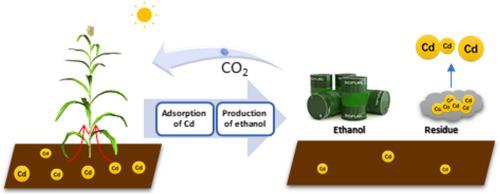Industrial Crops and Products ( IF 5.6 ) Pub Date : 2021-02-10 , DOI: 10.1016/j.indcrop.2021.113299 Ming-Zhao Xiao , Rui Sun , Zhi-Yan Du , Wen-Bin Yang , Zhuohua Sun , Tong-Qi Yuan

|
Cadmium (Cd) contaminant in soil can pollute crops and poison consumers higher in the food chain. Sorghum (Sorghum bicolor (L.) Moench) is a promising bioenergy crop that can absorb and accumulate Cd from soil while generate renewable biomass resources for bioethanol or other valuable products, and limit waste production by rational utilization of all components. In this study, a sustainable agricultural strategy was presented and six sorghum cultivars grown under field conditions for the phytoremediation of Cd-contaminated agricultural soil were investigated with the goal of comparing their ability to accumulate Cd and their theoretical bioethanol yields (Cd concentration in the soil was 0.25 and 0.96 ppm). Striking differences were found in the Cd accumulation of these sorghum cultivars, and the result indicated that the Cd accumulation in stalks increased with maturity. The total absorbability of Cd ranged from 19.6 to 148 g/ha, and N6G60 sorghum showed the highest Cd accumulation with a concentration of 9.16 ppm in the stalk on a dry basis. The theoretical yield of bioethanol ranged from 5510 to 7510 L/ha. The overall performance of N6G60 and 15016 sorghums surpassed that of other sorghum cultivars because of their stronger capacities for Cd translocation and higher theoretical yields of bioethanol. Considering the experimental results, as well as the potential ethanol yield and growing situations of sorghums, 15016 sorghum was considered the cultivar showing the most promise for future applications.
中文翻译:

利用高粱栽培种整合镉污染土壤修复和生物乙醇生产的可持续农业战略
土壤中的镉污染物会污染农作物,并毒害食物链中较高的消费者。高粱(高粱)(L.)Moench)是一种有前途的生物能源作物,可以吸收和积累土壤中的Cd,同时为生物乙醇或其他有价值的产品产生可再生的生物质资源,并通过合理利用所有成分来限制废物的产生。在这项研究中,提出了一种可持续的农业策略,并研究了在田间条件下生长的六个高粱品种,以对受Cd污染的农业土壤进行植物修复,目的是比较其积累Cd的能力及其理论生物乙醇产量(土壤中Cd的浓度)。为0.25和0.96 ppm)。这些高粱品种的镉积累存在显着差异,结果表明秸秆中镉的积累随着成熟而增加。Cd的总吸收能力为19.6至148 g / ha,N6G60和高粱表现出最高的Cd积累量,干态茎秆中的Cd含量为9.16 ppm。生物乙醇的理论产量为5510至7510 L / ha。N6G60和15016高粱的总体性能优于其他高粱品种,因为它们具有更强的Cd转运能力和更高的生物乙醇理论收率。考虑到实验结果,以及潜在的乙醇产量和高粱的生长状况,认为15016高粱是对未来应用最有前途的品种。N6G60和15016高粱的总体性能优于其他高粱品种,因为它们具有更强的Cd转运能力和更高的生物乙醇理论收率。考虑到实验结果,以及潜在的乙醇产量和高粱的生长状况,认为15016高粱是对未来应用最有前途的品种。N6G60和15016高粱的总体性能优于其他高粱品种,因为它们具有更强的Cd转运能力和更高的生物乙醇理论收率。考虑到实验结果,以及潜在的乙醇产量和高粱的生长状况,认为15016高粱是对未来应用最有前途的品种。









































 京公网安备 11010802027423号
京公网安备 11010802027423号